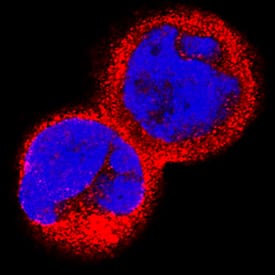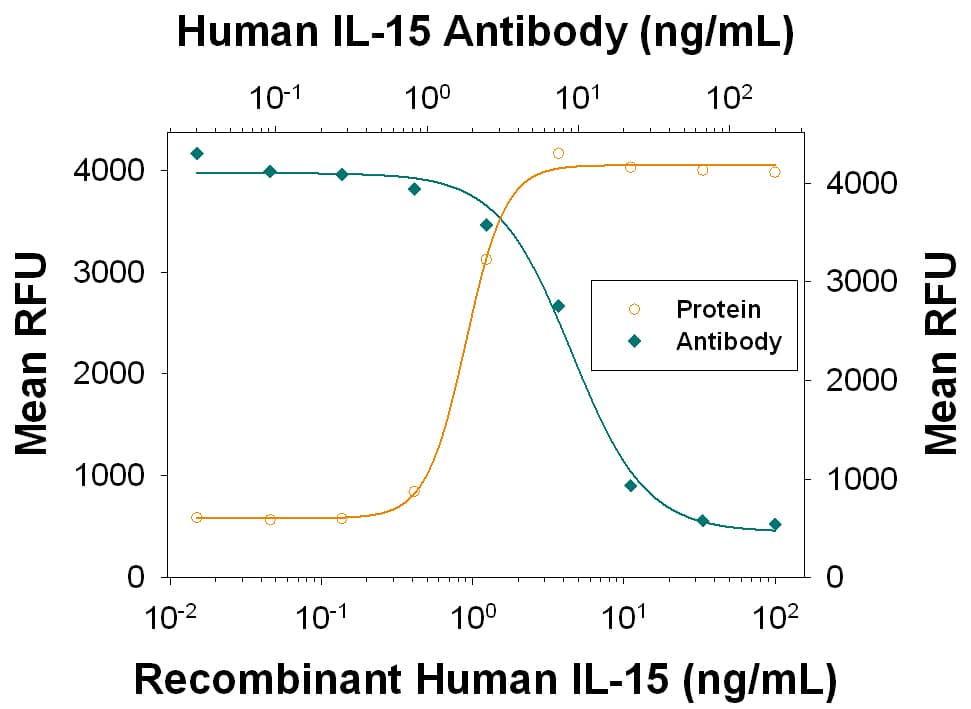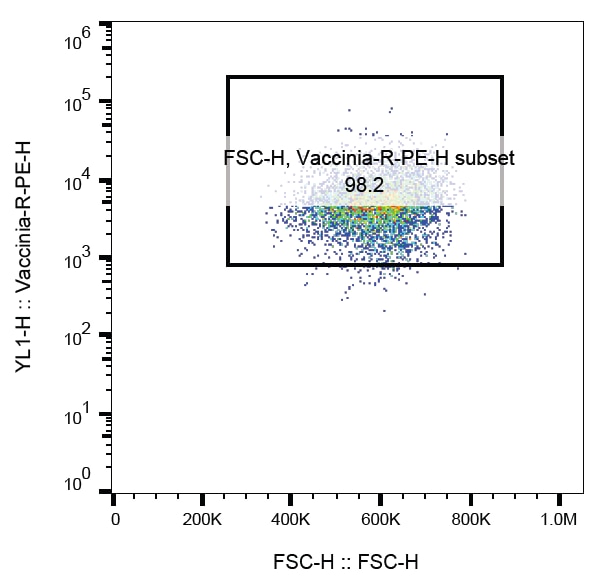Human IL-15 Antibody Summary
Asn49-Ser162
Accession # P40933
Customers also Viewed
Applications
Please Note: Optimal dilutions should be determined by each laboratory for each application. General Protocols are available in the Technical Information section on our website.
Scientific Data
 View Larger
View Larger
IL‑15 in Human Tonsil. IL‑15 was detected in immersion fixed paraffin-embedded sections of human tonsil using Goat Anti-Human IL‑15 Antigen Affinity-purified Polyclonal Antibody (Catalog # AF315) at 10 µg/mL overnight at 4 °C. Before incubation with the primary antibody tissue was subjected to heat-induced epitope retrieval using Antigen Retrieval Reagent-Basic (Catalog # CTS013). Tissue was stained using the Anti-Goat HRP-DAB Cell & Tissue Staining Kit (brown; Catalog # CTS008) and counterstained with hematoxylin (blue). View our protocol for Chromogenic IHC Staining of Paraffin-embedded Tissue Sections.
 View Larger
View Larger
Cell Proliferation Induced by IL‑15 and Neutralization by Human IL‑15 Antibody. Recombinant Human IL-15 (Catalog # 247-IL) stimulates proliferation in the MO7e human megakaryocytic leukemic cell line in a dose-dependent manner (orange line). Proliferation elicited by Recombinant Human IL-15 (10 ) is neutralized (green line) by increasing concen-trations of Goat Anti-Human IL-15 Antigen Affinity-purified Polyclonal Antibody (Catalog # AF315). The ND50 is typically 0.5-1.5 µg/mL.
Preparation and Storage
- 12 months from date of receipt, -20 to -70 °C as supplied.
- 1 month, 2 to 8 °C under sterile conditions after reconstitution.
- 6 months, -20 to -70 °C under sterile conditions after reconstitution.
Background: IL-15
Interleukin 15 (IL-15) is a widely expressed 14 kDa cytokine that is structurally and functionally related to IL-2 (1-3). Mature human IL-15 shares 70% amino acid sequence identity with mouse and rat IL-15. Alternate splicing generates isoforms of IL-15 with either a long or short signal peptide (LSP or SSP), and the SSP isoform is retained intracellularly (4). IL-15 binds with high affinity to IL-15 R alpha (5). It binds with lower affinity to a complex of IL-2 R beta and the common gamma chain ( gamma c) which are also subunits of the IL-2 receptor complex (1, 6). IL-15 associates with IL-15 R alpha in the endoplasmic reticulum, and this complex is expressed on the cell surface (7, 8). The dominant mechanism of IL-15 action is known as transpresentation in which IL-15 and IL-15 R alpha are coordinately expressed on the surface of one cell and interact with complexes of IL-2 R beta / gamma c on adjacent cells (9). This enables cells to respond to IL-15 even if they do not express IL-15 R alpha (8, 10). Soluble IL-15-binding forms of IL-15 R alpha can be generated by proteolytic shedding or alternate splicing (11-13). These molecules retain the ability to bind tightly to IL-15 and can either inhibit or augment IL-15 function (5, 12, 13). Consistent with its shared use of IL-2 receptor subunits, IL-15 induces IL-2-like effects in lymphocyte development and homeostasis (3). It is particularly important for the maintenance and activation of NK cells and CD8+ memory T cells (3). IL-15 also exerts pleiotropic effects on other hematopoietic cells and non-immune cells (2). Ligation of membrane-associated IL-15/IL-15 R alpha complexes induces reverse signaling that promotes cellular adhesion, tyrosine phosphorylation of intracellular proteins, and cytokine secretion by the IL-15/IL-15 R alpha expressing cells (14, 15).
- Grabstein, K. et al. (1994) Science 264:965.
- Budagian, V. et al. (2006) Cytokine Growth Factor Rev. 17:259.
- Ma, A. et al. (2006) Annu. Rev. Immunol. 24:657.
- Tagaya, Y. et al. (1997) Proc. Natl. Acad. Sci. USA 94:14444.
- Giri, J.G. et al. (1995) EMBO 14:3654.
- Giri, J. et al. (1994) EMBO J. 13:2822.
- Duitman, E.H. et al. (2008) Mol. Cell. Biol. 28:4851.
- Dubois, S. et al. (2002) Immunity 17:537.
- Stonier, S.W. and K.S. Schluns (2010) Immunol. Lett. 127:85.
- Burkett, P.R. et al. (2004) J. Exp. Med. 200:825.
- Budagian, V. et al. (2004) J. Biol. Chem. 279:40368.
- Mortier, E. et al. (2004) J. Immunol. 173:1681.
- Bulanova, E. et al. (2007) J. Biol. Chem. 282:13167.
- Budagian, V. et al. (2004) J. Biol. Chem. 279:42192.
- Neely, G.G. et al. (2004) J. Immunol. 172:4225.
Product Datasheets
Citations for Human IL-15 Antibody
R&D Systems personnel manually curate a database that contains references using R&D Systems products. The data collected includes not only links to publications in PubMed, but also provides information about sample types, species, and experimental conditions.
11
Citations: Showing 1 - 10
Filter your results:
Filter by:
-
A First-in-Human Phase 1 Study of Subcutaneous Outpatient Recombinant Human IL-15 (rhIL-15) in Adults with Advanced Solid Tumors
Authors: JS Miller, C Morishima, DG McNeel, MR Patel, HE Kohrt, JA Thompson, PM Sondel, HA Wakelee, ML Disis, JC Kaiser, MA Cheever, H Streicher, SP Creekmore, TA Waldmann, KC Conlon
Clin. Cancer Res., 2017-12-04;0(0):.
-
Discovery and characterization of a novel humanized anti-IL-15 antibody and its relevance for the treatment of refractory celiac disease and eosinophilic esophagitis
Authors: AP Vicari, AM Schoepfer, B Meresse, L Goffin, O Léger, S Josserand, N Guégan, S Yousefi, A Straumann, N Cerf-Bensu, HU Simon, Y Chvatchko
MAbs, 2017-06-05;0(0):0.
-
Efficient production and enhanced tumor delivery of engineered extracellular vesicles
Authors: Dionysios C. Watson, Defne Bayik, Avinash Srivatsan, Cristina Bergamaschi, Antonio Valentin, Gang Niu et al.
Biomaterials
-
Recombinant human heterodimeric IL-15 complex displays extensive and reproducible N- and O-linked glycosylation
Authors: M. Thaysen-Andersen, E. Chertova, C. Bergamaschi, E. S. X. Moh, O. Chertov, J. Roser et al.
Glycoconjugate Journal
-
TLR-9 and IL-15 Synergy Promotes the In Vitro Clonal Expansion of Chronic Lymphocytic Leukemia B Cells.
Authors: Mongini P, Gupta R, Boyle E, Nieto J, Lee H, Stein J, Bandovic J, Stankovic T, Barrientos J, Kolitz J, Allen S, Rai K, Chu C, Chiorazzi N
J Immunol, 2015-07-01;195(3):901-23.
Species: Human
Sample Types: Whole Tissue
Applications: IHC-P -
IL-15 amplifies the pathogenic properties of CD4+CD28- T cells in multiple sclerosis.
Authors: Broux B, Mizee M, Vanheusden M, van der Pol S, van Horssen J, Van Wijmeersch B, Somers V, de Vries H, Stinissen P, Hellings N
J Immunol, 2015-01-23;194(5):2099-109.
Species: Human
Sample Types: Whole Tissue
Applications: IHC-Fr -
Intramuscular delivery of heterodimeric IL-15 DNA in macaques produces systemic levels of bioactive cytokine inducing proliferation of NK and T cells.
Authors: Bergamaschi C, Kulkarni V, Rosati M, Alicea C, Jalah R, Chen S, Bear J, Sardesai N, Valentin A, Felber B, Pavlakis G
Gene Ther, 2014-10-02;22(1):76-86.
Species: Human
Sample Types: Cell Lysates
Applications: Western Blot -
Enrichment and persistence of virus-specific CTL in the brain of simian immunodeficiency virus-infected monkeys is associated with a unique cytokine environment.
Authors: Marcondes MC, Burdo TH, Sopper S, Huitron-Resendiz S, Lanigan C, Watry D, Flynn C, Zandonatti M, Fox HS
J. Immunol., 2007-05-01;178(9):5812-9.
Species: Primate - Macaca mulatta (Rhesus Macaque)
Sample Types: Whole Tissue
Applications: IHC-P -
Dendritic cells induce MUC1 expression and polarization on human T cells by an IL-7-dependent mechanism.
Authors: Vasir B, Avigan D, Wu Z, Crawford K, Turnquist S, Ren J, Kufe D
J. Immunol., 2005-02-15;174(4):2376-86.
Species: Human
Sample Types: Whole Cells
Applications: Neutralization -
Cloning and expression of feline interleukin 15.
Authors: Dean GA, Barger A, Lavoy A
Cytokine, 2005-01-21;29(2):77-83.
Species: Feline
Sample Types: Whole Cells
Applications: ICC, Western Blot -
NK cells regulate CD8+ T cell effector function in response to an intracellular pathogen.
Authors: Vankayalapati R, Klucar P, Wizel B, Weis SE, Samten B, Safi H, Shams H, Barnes PF
J. Immunol., 2004-01-01;172(1):130-7.
Species: Human
Sample Types: Whole Cells
Applications: Neutralization
FAQs
No product specific FAQs exist for this product, however you may
View all Antibody FAQsReviews for Human IL-15 Antibody
Average Rating: 5 (Based on 1 Review)
Have you used Human IL-15 Antibody?
Submit a review and receive an Amazon gift card.
$25/€18/£15/$25CAN/¥75 Yuan/¥2500 Yen for a review with an image
$10/€7/£6/$10 CAD/¥70 Yuan/¥1110 Yen for a review without an image
Filter by:




















